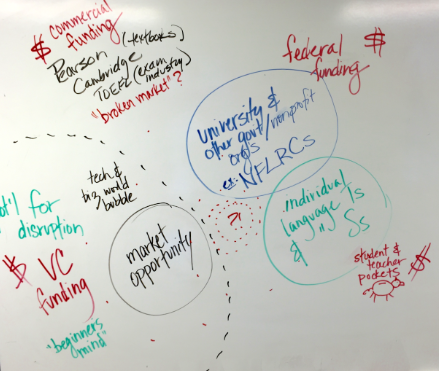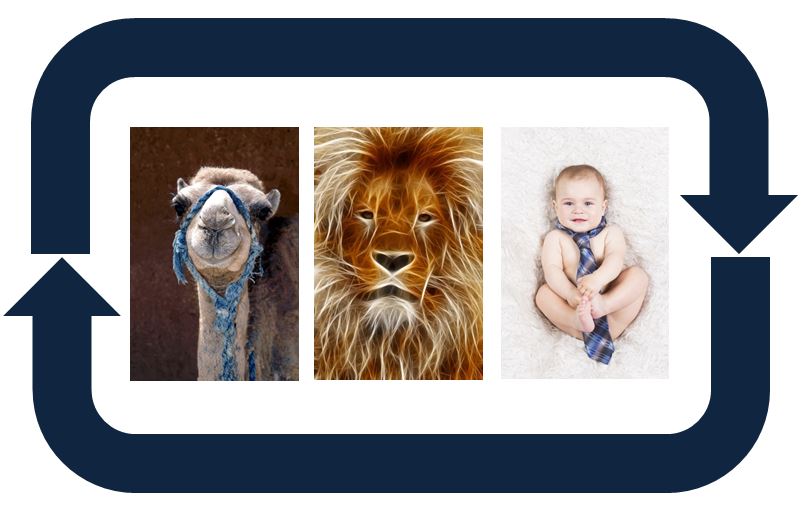Author: gabiguillen
Spanish Learning Resources
I have updated my list of +100 sites for Spanish learning. Search by category or keyword. Green is used for recommended resources. Make a comment on the original document to edit, add keywords, and share new sites.
Tailwinds for Critical Innovation in the Language Learning Field
Here is a brief article I wrote for the CASLS Intercom newsletter, released March 2, 2020. Subscribe to Intercom here, a must for language learning professionals.
The winds are favorable for the field of language education, with more than 777 language startups, a single app with more than 300 million users, and an online language learning market projected to grow by 18.61bn in the next four years. We should be suspicious about the commodification of language learning, and the proliferation of deceiving “magic pill” disruptors, but the truth is that none of us work for free as language professionals. What are we doing to make sure these resources are not wasted, positioning ourselves at the helm of our field for formal and informal learners who want to maintain and speak new languages? Higher education enrollments are declining and language learners are not in the business of giving language teachers work.
It is not a coincidence that the Center for Applied Second Language Studies (CASLS) at the University of Oregon asked me to write this piece. They are setting the pace for meaningful collaborations between academia and industry players and together we are planting the seeds of a Community of Practice for strengthened intersections between Instructed Second Language Acquisition, user-experience design, and product development. Millions of users are subscribing to language apps, but they often obtain disappointing results. We understand language development as a wicked humanitarian problem and our goal is to promote transformative tools, spaces, products, and tech jobs that address the complexity of learning a language, in other words, a new way of being in the word.
What I like about CASLS is not different from what I like about many intrapreneurs that I have interviewed in the last 10 years. They are thinkers and doers, critical innovators like that group of instructors at Princeton who created their own Spanish textbook, breaking up with an industry that benefits from a broken market. When I talked to them, I felt agency, a special and contagious energy such as the one that Joan Bajorek infuses in Women in Voice. Joan left a promising career in academia for a job in the tech industry and is now a role model for any applied linguist who is not seduced by the tenure-track path. And back to higher ed, recently two language professors at Yale started a course entitled Languages in Dialogue, blending Arabic and Hebrew. As challenging as it seems, one can only hope to see more multilingual initiatives such as this one, since the world outside of the classroom is rarely monolingual.
We face, indeed, a time for the language field to reconsider its relationship with innovation. The winds are more favorable than we think.

Gabriel Guillen (PhD) is an Associate Professor and the Director of the Summer Intensive Language Program at the Middlebury Institute of International Studies (MIIS). At MIIS, Gabriel teaches content-based language courses such as Spanish Social Entrepreneurship, Spanish Fake News, Spanish Digital Projects, Spanish Talks for Social Change, and Spanish in the Community, connecting his students with English learners in the Salinas Valley, California. With Robert Blake, he recently published Brave New Digital Classroom (2020), an overview on key concepts and challenges of teaching and learning languages with technology, with a new focus on social CALL (Computer-Assisted Language Learning). With Julie Sykes and Christopher Daradics from CASLS, and Thor Sawin from MIIS, Gabriel will be hosting the panel Mavericks of Mind: A Followup Report on Social CALL for Language and Technology Professionals at CALICO 2020.
Digital Storytelling Tools
Here are some free and partially free tools for telling your story. Use this site to add new sites or access direct links.
A Professional Metamorphosis

What kind of professional are you? A camel who asks what do I need to do? A lion who asks why do I need to do it? A child who wants to do it differently?
Close access to intellectual stimulation is one of many perks of being in academia. Last March I attended a workshop lead by my Language Studies (LS) colleague Michel Gueldry on “Integrating one’s personality by seeing what we don’t see,” as part of a series of workshops organized by another LS colleague, Jinhuei Dai.
Michel focused on self-observation and emotional intelligence by using, among other provocations, a parable by Friedich Nietzche, The 3 Metamorphosis of the Spirit, from Thus Spake Zarathustra.
Our discussion was so fertile that months later I still find myself going back to the three images of the spirit and re-purposing the metaphor. You don’t have to agree with Nietzsche’s teleology (from camels to lions and from lions to the child) to recognize the clear-sighted, evocative power of his writing.
“A child is innocence and forgetting, a new beginning, a game, a wheel that propels itself, a first movement, a sacred Yes. Yes, for the game of creating”.
Thus, I shared this parable with some colleagues who are participating in a series of conversations about transformative practice, teaching, and learning. What kind of professionals do we want to see graduating from our institutions? Camels? Lions? Children?
It’s easy to see the child as the entrepreneur, the creative type… A sacred yes! It’s sometimes the outsider with innovative ideas, the creator of disruptive solutions, prototypes, products and sometimes problems… But new problems. The child doesn’t understand or doesn’t care about the criticism, the destructive energy of the lion.
And the lion makes fun of the naïve kid. The lion fights imposed values, status quos, establishments, traditions, old habits… A sacred no! The lion is particularly cozy in the cages of academia but you can find them anywhere, fighting real or imaginary dragons. In the best scenario, they challenge our superficial ideas and make us better thinkers and doers.
The camel doesn’t get much credit. They are the comic butt of arrogant children. They are not always respected by the lion. And yet, we also need to think and act like camels. Yes. And by yes I mean no. No to Nietzsche! Kneeling down like the humble camel, accepting the existence of other values, traditions, practices and recognizing our own cultural burden… All of this is important, particularly in the academic context.
See the dromedary as the fast doer (camels are fast), willing to go the extra mile, able to store knowledge, able to make water from fat! In the worst scenario, camels get into professional traps, vicious circles, alienation, bulling, lacking the verbal muscle, the claws of the lion or the slippery skills of the child.
We all need to be camels, lions, and children. Competent, critical, and creative. The question is when and how. And how much. The answer should emerge from your own multiple experiences, values, goals, needs, adapting, blending with others, being curious, creating realities with the transformative stick of languages, ideas, methods, technologies, swimming furiously, making noise, scaring the sharks, going against the current… at the right time.
Are you the young fish asking what the hell is water? Are you the ape, the Vygotskian ape, sharpening your magic wands, interacting and learning from your peers? Are you a chameleon, a multilingual, multilayered professional, a blend of Malala Yousafzai, Noam Chomsky, Warren Buffet, Melinda Gates, MacGyver, and a Lonely Planet writer?
Can you do well and do good? I want to say yes. Others disagree.
